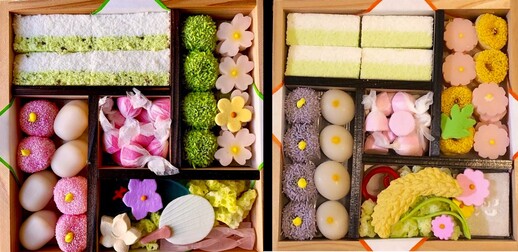2024.06.20
伝検通信(メルマガ)週刊メールマガジン「伝検通信」 第12号
週刊メールマガジン「伝検通信」第12号をお届けします。
今号は、宙ちゃんの「伝統文化一直線」 第7回 「四季の美をまとう菓子」をお届けします。
「クイズで肩慣らし」は前回クイズの答え・解説と、伝統色・文様分野からの出題です。
7月末までにメルマガ登録した方の中から、抽選で100人に公式テキスト(https://bookpub.jiji.com/book/b648563.html)をプレゼントするキャンペーンも引き続き実施中です! ぜひお近くの方にメルマガ登録をご案内ください。
目次
・ 宙ちゃんの「伝統文化一直線」 第7回 四季の美をまとう菓子
・ 「クイズで肩慣らし」第12回(伝統色・文様)=「役者文様」
・ 伝検協会だより
宙ちゃんの「伝統文化一直線」 第7回 四季の美をまとう菓子
近藤宙時=日本伝統文化検定協会理事

京都の老舗和菓子店「亀末廣」の「京のよすが」は季節によって内容が変わる。左から春、秋の商品。
口に入れるのがもったいないほどに美しく、味覚のない胃に送り込むのが惜しまれるほどのおいしさ。日本に生まれてよかったと、茶で口をすすぎながら至福の時に浸ることができるのが、和菓子です。ところで、老舗和菓子屋の跡継ぎが最初に取り組む修業は何だと思いますか?
実は、あんこ作りでもなければ、饅頭(まんじゅう)を丸めることでもありません。正解は、写生です。庭で草木をスケッチし、野山に行って風景を描く。それが、老舗和菓子屋の店主になる人物の最初の修業であり、次の代に引き継ぐ時まで続く日課なのだそうです。外に出て景色を写すことで、四季の移ろいを感じ、自然が描く形と色を知る。そして、その中で自然に根差した美意識を養い、それを菓子作りに生かす―。
和菓子にしかないと思える行事の一つに「お題菓子」作りがあります。宮中歌会始の勅題に沿った、意匠を凝らした和菓子を各店が作り、正月に発表するというものです。お題の他は全く制約がありません。1個幾らの材料費で作ろうが、饅頭でもよければ干菓子でもよく、色も形も自由です。自由なだけに店主の美意識だけでなく、教養から人格までが菓子に表れかねません。作品を持ち寄って品評会を開くこともあるようですが、そこでの批評よりも、お題菓子を楽しみに買いに来る客の、口には出さない感想が一番怖いといいます。通人たちの舌や目、教養に裏打ちされた感性にまで意図を伝え切れるかどうか。まさに和菓子職人の腕の見せどころです。
この行事を可能にしているのが、先に述べた店主の写生です。もっと言えば、普段は特に意識されることもない、自然に根付いた日本人の美意識と、織部焼(おりべやき)に象徴される自由奔放さだと思います。型を踏まえた上での型破り。それを端的に楽しめるのが、お題菓子です。
お題菓子だけではありません。どの和菓子も季節を教え、その季節をより深く味わわせてくれます。正月の花びら餅。春の桜餅や三色団子。端午の節句には粽(ちまき)に柏(かしわ)餅。夏には水羊羹(ようかん)、葛切り、ところてんが火照った体に涼を与えてくれます。栗きんとんを食せば、豊穣の秋が来たことを知ります。饅頭や打ち菓子、羊羹など、季節を問わない年中菓子さえもが季節によって姿や味の趣を変え、四季を楽しませてくれます。
写真は、京都の御菓子司(おんかしつかさ)亀末廣の「京のよすが」です。地元では「四畳半」として親しまれ、年に14回、がらりと装いを変えることで知られます。有平糖(ありへいとう)、寒氷(かんごおり)、求肥(ぎゅうひ)餅、練り切り、落雁(らくがん)、州浜(すはま)、松露(しょうろ)、雲平(うんぺい)、片栗、そぼろ、種あわせ…。それぞれ別個の最高の技術で作られ、姿も味も全く異なりますが、それらが一体となって京都の四季の移ろいをまとうのです。
ちなみに亀末廣には、「京の土」という大きな麩(ふ)焼きせんべいもあります。こちらは一見すると、その名の通り菓子には思えないほど枯れた姿をしています。印象派を思わせる色鮮やかな菓子から、まるで水墨画のような菓子まで、いずれにしても和菓子は極めて絵画的な菓子だと言えます。
そういえば、日本の洋菓子は和菓子の絵画的な自由さに感化されてか、いつの間にか世界一美しく、かわいく、おいしくなったと思います。和菓子が世界を魅了する日も近いでしょう。
「クイズで肩慣らし」第12回(伝統色・文様)=「役者文様」
~伝検公式テキスト(9月1日刊行予定)のジャンルごとに出題します~

役者文様
第12回
問題:歌舞伎の「役者文様」は、江戸時代に歌舞伎役者がそれぞれの宣伝のため、屋号の紋や文様を組み合わせて考案し大流行しました。その一つ、この役者文様は何というでしょう。
【前回の答えと解説】
問題:高く澄んだ音が特徴の「南部風鈴」は、岩手県の代表的な工芸品。ホームに飾られた風鈴の音色が「残したい日本の音風景100選」にも選ばれ、夏の観光名所となっている駅はどこでしょう。
答え:水沢駅
解説:1996年に環境庁(現環境省) が選定した「残したい日本の音風景100選」に選ばれた、JR東北本線水沢駅(岩手県奥州市)の南部風鈴(南部鉄器の風鈴)。水沢駅では、毎年6月から8月にかけて駅構内に数多くの南部風鈴がつるされ、夏の風物詩として観光名所となっています。余談ですが、南部鉄器は、奥州市では平安時代後期に奥州藤原氏が近江から鋳物師を招き武具などを作らせたことが、盛岡市では江戸時代中期に南部藩主が京都から釜師を招き茶釜を作らせたことが、それぞれ始まりとされています。
伝検協会だより
伝検協会は6月17日に第3回の理事会を開催しました。理事会前に、今年度から協会会員となっていただいた松竹、西武ホールディングス、三菱UFJフィナンシャル・グループの各担当者の皆さまに挨拶をしていただきました。「日本文化の発信がわれわれのミッション」 「自社の取り組みと伝検との連携を考えていきたい」といったコメントがあり、事務局も大いに意を強くしました。
理事会では、2023年度の事業報告と決算を承認。検定事業の進捗(しんちょく)状況に関する報告では、出席者から合格率の見通しに関する質問が出ました。検定の難易度をどうすべきかは頭を悩ませています。難しすぎると、受験者のやる気を削ぐ可能性がある一方、合格率が10%未満の検定もあり、「その難しさがチャレンジ精神を刺激している」といった意見もあります。合格率がどうであろうと、伝検はテキストからの問題出題率が3級で90%以上、2級で70%以上ですので、テキストをしっかり勉強することが合格への近道であることは間違いありません。
公式テキスト
https://bookpub.jiji.com/book/b648563.html
編集後記
伝検通信第12号をお届けしました。伝検公式テキストは多領域にわたる「日本の伝統文化」を知るための基本書になると思われます。今まで、こうした総合的な検定やテキストがなかったことは驚きだと、昨日、在外公館勤務経験のある方から伺いました。外国の方に日本の伝統文化を説明したり、自らの教養を深めたりする上でも役立つテキストとなりそうで、とても楽しみです。
カテゴリー: 伝検通信(メルマガ)





